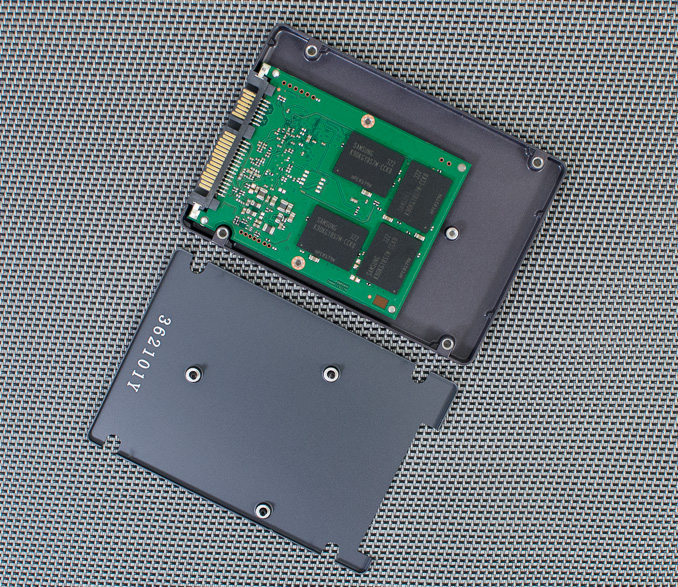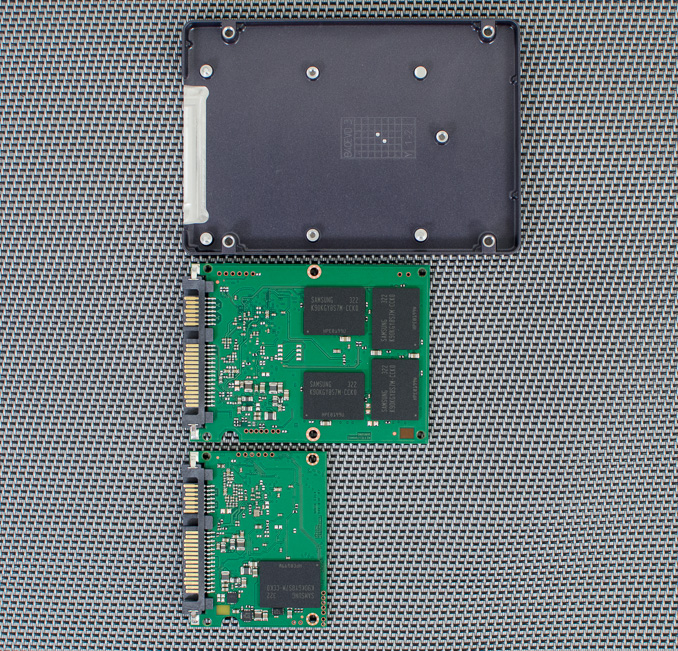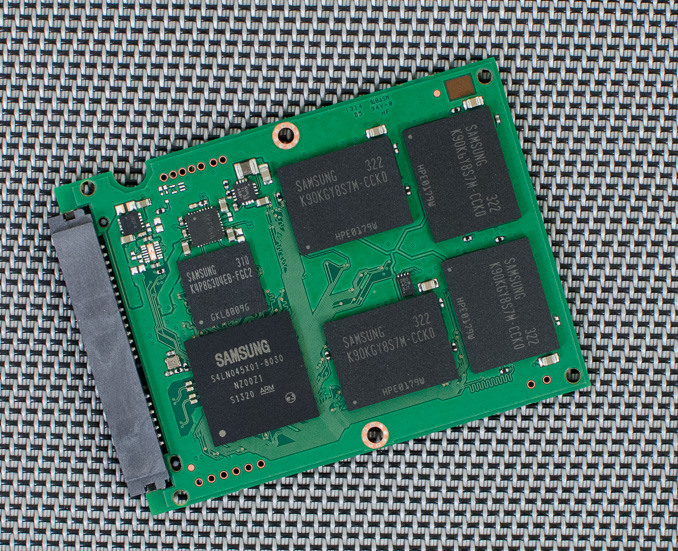Samsung SSD 840 EVO Review: 120GB, 250GB, 500GB, 750GB & 1TB Models Tested
by Anand Lal Shimpi on July 25, 2013 1:53 PM EST- Posted in
- Storage
- SSDs
- Samsung
- TLC
- Samsung SSD 840
Inside the Drives & Spare Area
The EVO is offered in a single form factor - 2.5" at a 7mm thickness. There are three torx (T5) screws that hold the chassis together, removing them gets you a look at the EVO's very simple internals. Surprisingly enough there's no thermal pad between Samsung's MEX controller and the chassis.
Samsung, like Intel, does a great job of reducing the number of screws and simplifying the assembly of its drives. I would prefer if Samsung didn't insist on using torx screws to hold the chassis together but I'm sure it does have some impact on reducing returns. There's also growing concern of counterfit SSDs which I guess screw choice could somewhat address.
There are two PCB sizes used in the EVO lineup, neither of which occupies the full volume of the 2.5"/7mm chassis. The 120 and 250GB drives use the smallest PCB, while the other drives use the larger layout. The larger PCB has room for 8 NAND packages, while the half length PCB can accommodate two. Each of the NAND packages can hold up to 8 x 128Gbit 19nm TLC die.
To deal with the realities of TLC, Samsung sets aside more of the drive for use as spare area on the EVO than it does on its MLC Pro line. Due to TurboWrite however, the percentage is actually a bit less than it was on last year's 840.
| Samsung SSD 840 EVO Memory | |||||||
| Advertised Capacity | 120GB | 250GB | 500GB | 750GB | 1TB | ||
| DRAM Size | 256MB LPDDR2-1066 | 512MB LPDDR2-1066 | 512MB LPDDR2-1066 | 1GB LPDDR2-1066 | 1GB LPDDR2-1066 | ||
| # of NAND Packages | 2 | 2 | 4 | 8 | 8 | ||
| # of NAND die per Package | 4 | 8 | 8 | 4 | 8 | ||
| NAND Capacity per Package | 64 GiB | 128 GiB | 128 GiB | 96 GiB | 128 GiB | ||
| Total NAND | 128 GiB | 256 GiB | 512 GiB | 768 GiB | 1024 GiB | ||
| Spare Area | 12.7% | 9.05% | 9.05% | 9.05% | 9.05% | ||
I've tossed internal shots of all of the EVO lineup into the gallery below:



















137 Comments
View All Comments
B0GiE-uk- - Thursday, July 25, 2013 - link
Seeing as this drive is similar to the 840 basic, it will be interesting to see the performance of the 840 Pro with the rapid software enabled. Has the potential to be faster than the EVO. I have heard that the rapid software will be backwards compatible.sheh - Thursday, July 25, 2013 - link
Caching speed is based on RAM, flushing speed on drive. I don't think there will be any surprises.Heavensrevenge - Thursday, July 25, 2013 - link
Finally were seeing transition to RAM caches, it's nice a RAM disk is being utilized and I hope the trend continues so that HDD/SDD can actually be taken out of the storage hierarchy for the OS & operating memory and have EVERYTHING reside in a non-volatile RAM space together for CRAZY increases in perf since HDD's in a way are a side-effect of old memory's being so small there had to be a drive backing the RAM. But of course we need traditional storage for actual storage purposes afterwards. But I'll hope for a migration of RAM towards a similarly fast combination of RAM+Drive being the main root drive built right onto the motherboards in a stick-like way within 10 years to cause a nice little computing revolution via re-architecting the classical storage hierarchy that's now, I believe, is quite possible and reasonable.DanNeely - Thursday, July 25, 2013 - link
Modern OSes have been doing ram cache for years. Samsung is able to "cheat" with rapid because they've got a much better view of what the drive is doing internally to optimize for it (even if the data isn't normally exposed via standard APIs). Eventually OS authors will catch up and have SSD optimized caches instead of HDD optimized ones and it will again be a moot point.Jaybus - Thursday, July 25, 2013 - link
Yes. It is doing the same thing as the O/S cache, but using a different algorithm to decide which blocks to cache, one that is tailored to SSD. So the O/S is very likely to adapt something similar in future.What is more interesting is TurboWrite. If you consider the on board DRAM a L1 cache, then TW implements a more-or-less L2 cache in NAND by using some of the NAND array in SLC mode instead of TLC mode. In addition to greater endurance, SLC mode allows much faster P/E cycles than TLC (or MLC). And unlike the DRAM cache, the SLC-mode NAND cache is not susceptible to power failure data loss. It still is not nearly as fast as DRAM, so the L1 DRAM cache is still needed. Encryption would kill performance without DRAM. But because data can be moved from DRAM cache to SLC cache more quickly, it frees up DRAM at a faster rate and increases throughput. So unless writing an awfully lot of data continuously, you essentially get SLC performance from a TLC drive. That is the EVO (lutionary) thing about this drive, much more so than RAPID software.
Heavensrevenge - Thursday, July 25, 2013 - link
Heh yes of course, I mean removing the "hard drive/solid state drive" out of the storage hierarchy completely and putting all OS and cache data into non-volatile silicon where the ram sits today, making all operations go as fast as ramdisk speed, not just have it there as a way to hide latency. like boot from the modules plugged directly into the motherboard and everything :) THATS what I'd love to see, 1-2GB/s 4K read & write speeds all-around not just for special use cases, All because the fab process is becoming small enough o fit the amount of data there we can actually re id f that part of the storage hierarchy if you know what I mean.Spunjji - Friday, July 26, 2013 - link
I think there's always going to be a space for slower, more density-efficient storage in any sensible storage hierarchy. I think what you're looking forwards to is MRAM / PRAM, though. :)Heavensrevenge - Saturday, July 27, 2013 - link
MRAM or any NVRAM is basically the concept I was wanting :) Thank you for the reference!!The day/year/decade that type of memory become our RAM & OS/Boot drive replacement in the storage hierarchy will be the one of the best times in modern computing history.
Honestly all HDD/SDD manufactures should stop wasting their R&D on this type of crap even though SSD's are a wonderful "now" solution to the problem and I'll still recommend them for the time being.
The sooner that type of memory is our primary 1st level storage directly addressable from the CPU the better our modern world of computing will become and begin evolving again.
MrSpadge - Saturday, July 27, 2013 - link
I don't think Samsung is doing anything better here, or working some SSD-magic. They're just being much more agressive with caching than Win dares to be.Touche - Thursday, July 25, 2013 - link
I don't think your tests are representative of most people's usage, especially for these drives. TurboWrite should prove to be a much better asset for most, so the drive's performance is actually quite better than this review indicates.